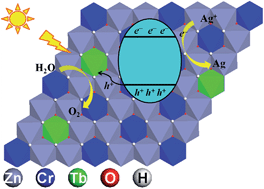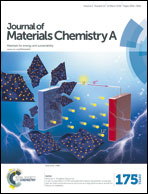Terbium doped ZnCr-layered double hydroxides with largely enhanced visible light photocatalytic performance†
Abstract
Recently, layered double hydroxides (LDHs) have emerged as highly active photocatalysts due to their unique structure, large specific surface area and semiconductor properties. However, the slow interfacial kinetics and fast charge recombination are the major obstacles which limit the performance of LDH-based photocatalysts. Here, we demonstrate the doping of rare earth ions into the host layer of LDHs to inhibit the charge recombination and increase the charge injection efficiency simultaneously. A series of terbium ion (Tb3+) doped ZnCr–LDHs (Tb-ZnCr–LDHs) have been successfully synthesized via a co-precipitation method, and their photocatalytic water splitting activities were evaluated under visible light irradiation. The sample with a Tb3+ doping content of 0.5% (molar ratio) shows optimal performance for oxygen evolution (1022 μmol h−1 g−1) among all these Tb-ZnCr–LDH materials. The photoluminescence and photoelectrochemistry measurements over the Tb-ZnCr–LDH samples prove effective separation of photo-induced charge carriers and high charge injection efficiency, compared with a pristine ZnCr–LDH. This strategy can be applied to modify other photocatalysts toward low-cost solar fuel generation systems.


 Please wait while we load your content...
Please wait while we load your content...